Have you ever heard, or have you ever been told, “all this piano needs is just a good tuning?” I hear this all the time…mostly from clients who were quoting the person who was giving, or selling them, the piano! Usually, the piano does need a good tuning, but more often than not, the piano needs additional repairs and/or adjustments before the piano can be tuned properly and function at a descent level.
The fact is that tuning is only a very small portion of what a piano needs to produce a beautiful tone, produce a wide range of dynamic color, and allow for a wide variety of rhythmic control.
In another blog article of mine, “Tuning, Repairs, and Regulation. The Difference?” I explain, in detail, the differences between Tuning, Repairs, and Regulation. For the remainder of this article, Repairs, Regulation, and Voicing will often be referred to as EVERYTHING ELSE! While tuning is important, it’s EVERYTHING ELSE that really “makes or breaks” a piano. It’s EVERYTHING ELSE that often differentiates between a so-so piano and one that is enjoyable to play and easy to listen to (assuming all things tuning-wise being equal and of good quality).
Tuning, of course refers to adjusting the tuning pins to create proper pitches and scale on a piano. Repairs refer to just that…repairs…fixing broken or damaged parts so that the piano can be regulated properly. Regulation refers to adjusting all the many parts on a piano so they work as they should with each other. Every piano action has a certain geometry of parts, (distances, thicknesses tolerances, etc) that allow it to work properly as a machine. When those parts change size and shape because of humidity, wear and tear, or even being converted to mice nesting!…the ability of the piano to function properly suffers. And, Voicing refers to the careful preparation of the hammer’s felt for optimal attack and tone.
That said, while tuning is important because that’s what we ultimately hear, the piano will not make music unless the action is working like it should.
It’s important to note that my point in this article is NOT to give cold hard facts and numbers for you to fact check me. My goal is basically to give you a mental picture of the relationship between, and draw more attention to, the “EVERYTHING ELSE” things in a piano that usually get neglected.
More specifically, the purpose of this article is to 1) reiterate that there is a definite difference between basic TUNING and EVERYTHING ELSE a piano needs, and 2) help put into perspective the fact that because there are many more parts and adjustments involved in the action of the piano that relate to FUNCTION than that required for TUNING, it stands to reason that a majority of our time and effort working on a piano will often be (or should be) things other than tuning. At the very least, one should not be surprised when when the tuner recommends certain services in addition to a regular tuning.
In my little world in which I live and work, I find that most new piano owners believe (or believed at some point) that ALL their piano really ever needs IS tuning. Hopefully, by the end of this article, it will be easier to understand why that is just not true.
What do you mean, my piano needs more than just tuning?
While tuning gets all the glory, the reality is that behind the scenes there are thousands of parts trying to work together to make the strings “look good”! You read it right…”look good!” Like a pit crew working hard behind the scenes to make the driver of the Indy 500 look good! Like a stage crew, setting up for days, leaving nothing to chance, all for a 1 hr. show that will make the performers “look good,” and satisfy the audience. Sadly, too often the many piano parts are handicapped in doing their jobs…and can’t make the strings “look,” or sound good because they are being forced to function at a mere fraction of their potential due to years of wear and tear, or just plain neglect. Over time, parts wear out and change shape, thus changing the relationship between them and other parts.
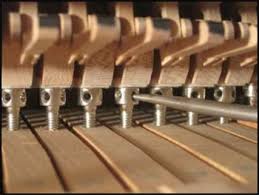
Capstan Adj. at end of Keys
The Ability to Adjust (Regulate)
Fortunately, piano manufactures build into each piano many points of adjustment to compensate for this wear, but unfortunately, the adjustments don’t usually get done. Many inexperienced tuners don’t even know how to make many of these adjustments, at least not properly (Honestly, I didn’t as a beginner). Even if they do know how, many times the needed repair and maintenance jobs are left undone because of things like apathy, lack of time, lack of financial means or compensation, motivation, and such (by either the client and/or tuner). The fact is, that piano parts that aren’t aligned and adjusted properly will wear more quickly. Eventually, the parts wear so much that adjustments can no longer be made to compensate for the extreme wear, and the parts must be replaced, then re-regulated.
Your Piano Needs Regular Maintenance, Just Like Your Vehicle!
A piano is not much unlike your vehicle. How your vehicle looks (inside and out), the feel of the interior (the sleek console with all the latest bells and whistles on the dashboard), and things like that seem to get most of our attention, while under the hood there are thousands and thousands of critical parts that make your vehicle run smoothly, and safely. Those thousands of parts are slowly wearing out with every passing mile, yet we don’t think of it…nor do most of us know what those thousands of hidden parts are, or what they do. They just work! Most of us, myself included, tend to just put gas in the vehicle and expect it to perform, often forgetting that it needs regular repairs and maintenance; e.g. an oil change, belts changed, tires rotated, balance, and aligned, wipers changed, etc. We often ignore a problem, or live with it, until something drastic happens, forcing us to make a repair or adjustment.
Case in point. After a year or more, I finally got tired of the loud road noise my truck tires were making because I had failed to have them rotated at regular intervals. It became so loud, it made everyone nervous riding with me, not to mention that my clients could hear me coming a mile away. It came on so slowly, though, I almost didn’t notice. I thought my truck was just getting old, more rattly, more noisy, etc. WOW! After getting new tires, it sounded and handled like a totally different vehicle. All the gas in the world wouldn’t make it run smoother when what it needed was new tires.
The piano is no different, and I feel that many people don’t really notice the subtle changes their piano makes over the years as it slowly develops rattles, and clicks. Many owners write it off as normal aging issues that has now become the new character of their piano, they resign themselves to it being “just the way it is.”
The Good News: It Doesn’t Have to Stay That Way!
While tuning is necessary at regular intervals (like putting gas in your vehicle), tuning alone will never make the piano function better. Function is only improved by good repair, regulation, and voicing. My clients are often pleasantly surprised at how wonderful their otherwise average instrument can sound with a bit of Tender Loving Care in the repair, regulation, and voicing department! I could just tune the piano and leave the piano at average, but it’s so much more gratifying when a few repairs here, and a few adjustments there can transform an average piano to something a bit better. Agreed, not all pianos are cut out to be great pianos, but most pianos can be improved some, if not, a lot!
Did you know that tightening all the action screws eliminates a lot of clicking noises and makes the action feel less sloppy. Shaping and voicing the hammers can greatly improve tone. Cleaning the dirt out of the action and properly lubricating friction points can improve repetition speed of a note. Adjusting the hammer blow distance (how close the hammers are from the strings) and let-off (how close the hammers are to the strings when escapement happens) has a huge effect on power, tone, repetition, dynamics, etc, etc. All this is usually taken for granted as being set in stone for any given piano, but it’s not. There is often MUCH that can be done to improve the play-ability of a piano that goes beyond just tuning.
Since PIANO FUNCTION is so important, and directly affects every aspect of piano playing (including whether or not your instrument is enjoyable or frustrating to play), it is worth considering having a discussion with your piano technician regarding what repairs, regulation, and voicing your piano might benefit from, in addition to regular tuning!
A Little TLC = BIG play-ability/tone improvement.
BIG play-ability/tone improvements = More enjoyment!
NOTE: Expect to pay additional charges for EVERYTHING ELSE services that go much beyond tuning. Some technicians, like myself, often make minor adjustments included in the regular tuning fee if it doesn’t take too long, or is too cumbersome, however, it is highly typical to separate tuning charges from EVERYTHING ELSE charges. Maintenance work is often very time consuming and is charged accordingly.
Now For Some Numbers:
Lets Compare Tuning vs Everything Else!
OK, now just for fun…lets compare TUNING vs EVERYTHING ELSE a piano needs as a ratio (a fraction). This should help put things into perspective.
For this example, we are considering a basic run-of-the-mill console piano, though, the concept is true for all pianos. Also, don’t get caught up in the numbers. This is for example only!
Also, we will only be considering a single note on the piano, let’s say the 1st and lowest note on the piano.
Again, be reminded that tuning just refers to tightening or loosening a piano string to make a proper pitch. That’s all. Everything from the key to the hammer is considered the action and affects the function of the note.
So, let’s compare:
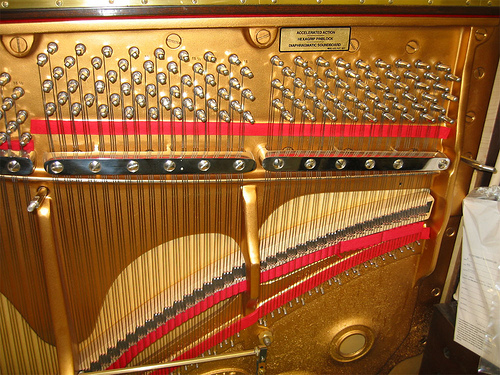
Strings on Plate
TUNING: Thinking of just the harp inside the piano, (picture the action “guts” removed, a single note in the low bass of the piano has just 1 adjustment to tune that note and there are only about 5 parts involved (1 string, 1 tuning pin, 1 hitch pin, 1 agrafe, and the plate). That’s it. With those parts in proper place, the tuning pin can be turned and by plucking the string, you will hear the pitch rise until you’re satisfied that it’s IN TUNE. As a side note, now imagine the whole harp that way. Basically just tuning pins and piano wire brought up to proper tension to create a proper scale. The piano is now “IN TUNE” but besides plucking each string, one cannot even begin to properly play a single note without the “action” or “guts” in it. So a piano can be “IN TUNE” but not playable. This is important to your understanding why tuners separate the processes when billing for tuning vs repair and regulation services. Two different animals.
Ok, now back to our single note comparison…
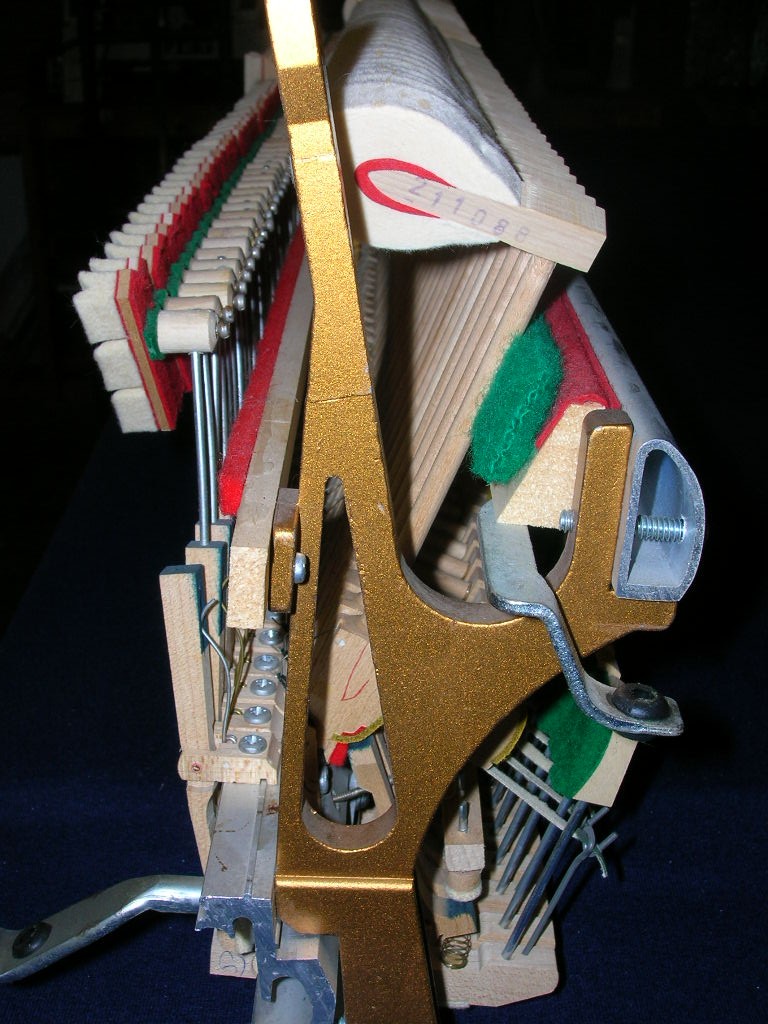
Console Action – Side View
EVERYTHING ELSE:
Now, lets think about what it takes to make the piano playable. Parts. Lots and lots of parts. Key parts, parts to keep the keys all in line and not rubbing one another, parts to transfer energy from the back of that key to the whippen, parts on the whippen that transfers energy to the hammer…but also must not allow the hammer to block against the string but bounce off the string…..but only once. That’s a basic explanation, but there’s a whole lot more to it than that. But, for the sake of discussion, lets assume that for that very same bass note that we placed IN TUNE earlier, that we count up all the little individually manufactured parts that: make up the key, hold the key in place, parts that make up the whippen, parts that make up the hammer, and such (wood parts, metal parts, felt parts, rubber parts, plastic parts, leather parts, etc.)
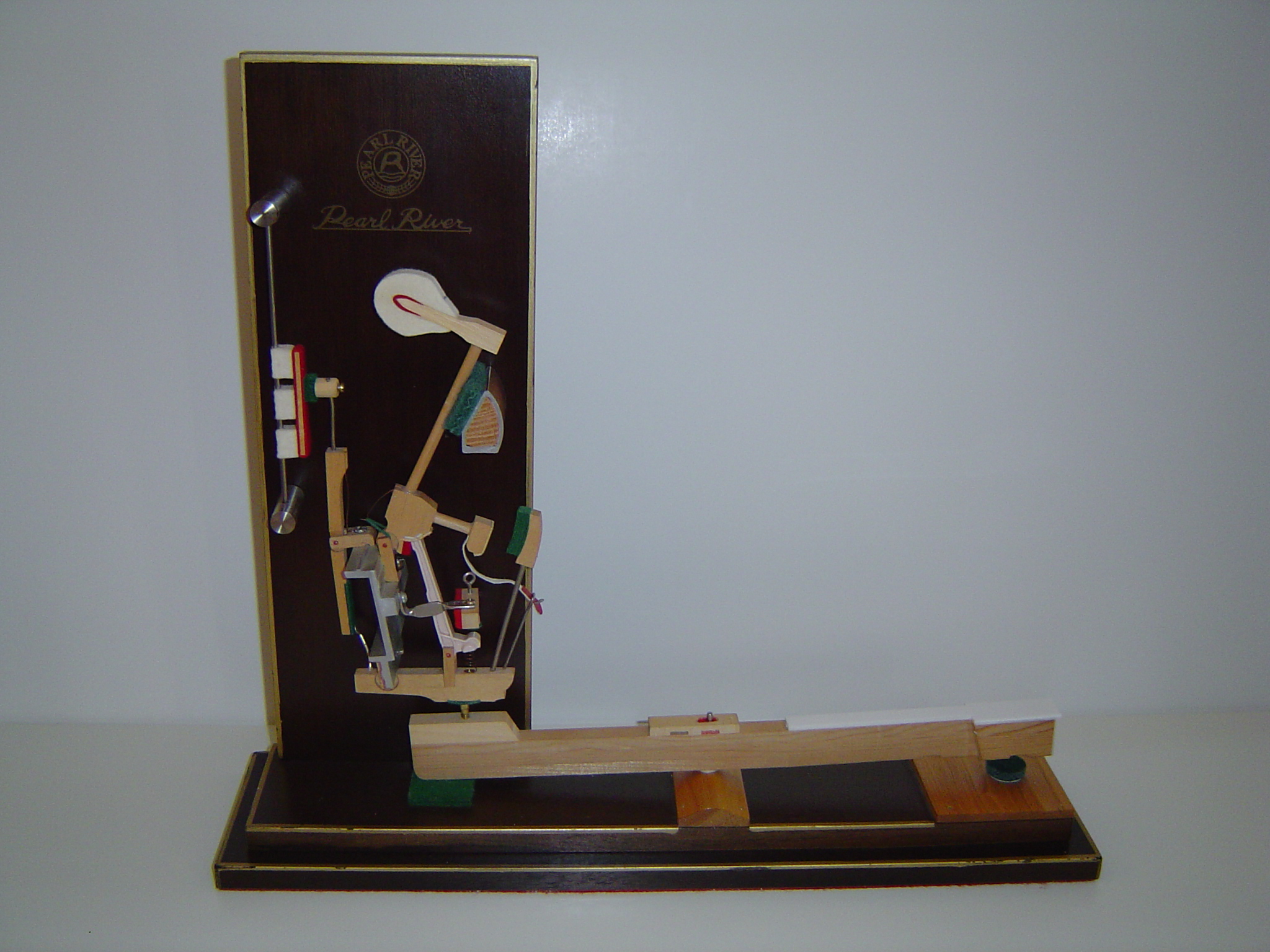
Console Action Model
On that one note on the piano, there could be in excess of 70 pieces that make up the parts that form the action that makes a note play (on my upright action model, I counted about 70 individual pieces or parts (more for a grand). Keep in mind that each part must be of correct size and shape to do its job. Each part must be in good repair. Each part must be attached structurally sound by glue, screw, etc. Each part must be aligned and adjusted to function with other parts. Also keep in mind, age, temperature, humidity, and normal wear throughout a piano’s life will change the shape, size, and adjustments of all these thousands of parts. Similarly, on that same one note, there are approx. 14 or 15 adjustments that need to be correct in order for the note to play properly. On a grand, the number of parts per note are higher, as is the number of adjustments (in the neighborhood of 30-35).
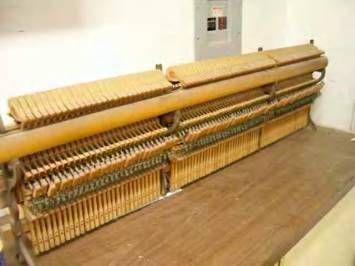
Complete Console Action
SO…lets consider a couple ratios.
TUNING : REGULATION ratio (1:15 per note)
(1 tuning pin adj. to tune : 15 possible adjustments in the action for that same note)
# STRINGING Parts : # ACTION Parts (5:70) (reduced 1:14)
(5 stringing parts : 70 action parts for one note in the piano)
Put the two together and what do we get?
TUNING to EVERYTHING ELSE 6:85 or (1:14 minimum)
TUNING (stringing parts 5 + tuning adjustment 1)=6 : ACTION PARTS 70 and REGULATION 15)=85
Now to blow your mind a little more, multiply that more or less by 88 notes on the piano.
Avg. piano has approx. 250 strings to tune.
Avg. console has roughly 15 regulation points per note (x88) = 1,320
Avg grand may have nearly 30 regulation points per note (x88)=2,640
Keep in mind that does not include the repair possibilities per note. That’s just possible adjustments that need to be set correctly for the piano to function as it should! Now, that’s a LOT of potential adjustments and repairs throughout the piano vs. simply tuning 250 strings.
I know this is not terribly scientific, and I’m sure there are those who write the thick books who could consider probability, permutations, and all that high math to come up with something better, but I’m probably not way off base in making the point that there is much more under the hood of a piano that needs attention than just tuning, and while tuning gets all the glory and attention, it is but a very small part of the piano ownership/maintenance equation.
So, that piano that was given (or sold) to you (nice or not…old or new) as “only needing a good tune-up,” well, don’t believe it…at least for the majority of pianos.
A good rule of thumb: when you receive your piano, whether by gift or sale, go into the transaction expecting that it may need more than just a tuning, then when it does…you’re not surprised and upset with the seller. And, IF you’re fortunate enough that it really doesn’t need a lot of work, then count your blessings…you’re miles ahead! Just be smart and start planning for when it WILL need it…..because sooner or later, just like your vehicle, it will!
My hope is not to discourage you about your piano by putting doubt in your mind about the real condition of your piano, extra costs that it might require, etc. But, I hope that it served to educate you, and encourage you, that if you’ve been putting up with a frustrating piano, wondering why it doesn’t play like you think it should, or accepting its slow demise as being normal….there may be hope. Tuning alone won’t fix it, but I know there are plenty of qualified technicians who would be glad to help you breathe new life into your piano, should that be your desire!
Keep TUNING your piano….but don’t forget about EVERYTHING ELSE!
Until next time….”make a joyful noise!”